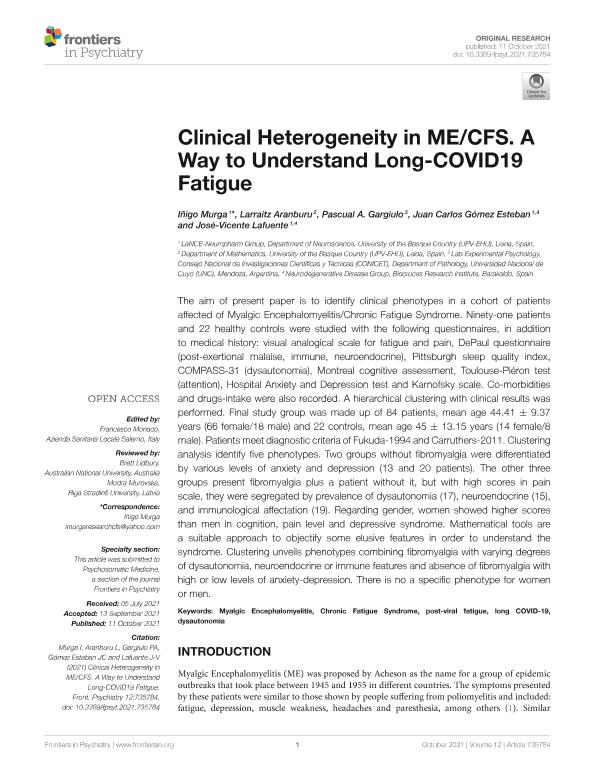Mostrar el registro sencillo del ítem
dc.contributor.author
Murga, Iñigo
dc.contributor.author
Aranburu, Larraitz
dc.contributor.author
Gargiulo, Pascual Angel

dc.contributor.author
Gomez Esteban, Juan Carlos
dc.contributor.author
Lafuente, Jose Vicente
dc.date.available
2022-05-11T13:39:02Z
dc.date.issued
2021-10
dc.identifier.citation
Murga, Iñigo; Aranburu, Larraitz ; Gargiulo, Pascual Angel; Gomez Esteban, Juan Carlos; Lafuente, Jose Vicente; Clinical Heterogeneity in ME/CFS: A Way to Understand Long-COVID19 Fatigue; Frontiers Media; Frontiers in Psychiatry; 10-2021; 1-9
dc.identifier.issn
1664-0640
dc.identifier.uri
http://hdl.handle.net/11336/157197
dc.description.abstract
The aim of present paper is to identify clinical phenotypes in a cohort of patients affected of Myalgic Encephalomyelitis/Chronic Fatigue Syndrome. Ninety-one patients and 22 healthy controls were studied with the following questionnaires, in addition to medical history: visual analogical scale for fatigue and pain, DePaul questionnaire (post-exertional malaise, immune, neuroendocrine), Pittsburgh sleep quality index, COMPASS-31 (dysautonomia), Montreal cognitive assessment, Toulouse-Piéron test (attention), Hospital Anxiety and Depression test and Karnofsky scale. Co-morbidities and drugs-intake were also recorded. A hierarchical clustering with clinical results was performed. Final study group was made up of 84 patients, mean age 44.41 ± 9.37 years (66 female/18 male) and 22 controls, mean age 45 ± 13.15 years (14 female/8 male). Patients meet diagnostic criteria of Fukuda-1994 and Carruthers-2011. Clustering analysis identify five phenotypes. Two groups without fibromyalgia were differentiated by various levels of anxiety and depression (13 and 20 patients). The other three groups present fibromyalgia plus a patient without it, but with high scores in pain scale, they were segregated by prevalence of dysautonomia (17), neuroendocrine (15), and immunological affectation (19). Regarding gender, women showed higher scores than men in cognition, pain level and depressive syndrome. Mathematical tools are a suitable approach to objectify some elusive features in order to understand the syndrome. Clustering unveils phenotypes combining fibromyalgia with varying degrees of dysautonomia, neuroendocrine or immune features and absence of fibromyalgia with high or low levels of anxiety-depression. There is no a specific phenotype for women or men.
dc.format
application/pdf
dc.language.iso
eng
dc.publisher
Frontiers Media

dc.rights
info:eu-repo/semantics/openAccess
dc.rights.uri
https://creativecommons.org/licenses/by/2.5/ar/
dc.subject
LONG COVID-19
dc.subject
MYALGIC ENCEPHALOMYELITIS
dc.subject
CHRONIC FATIGUE SYNDROME
dc.subject
POST-VIRAL FATIGUE
dc.subject
DYSAUTONOMIA
dc.subject
COVID-19
dc.subject.classification
Psiquiatría

dc.subject.classification
Medicina Clínica

dc.subject.classification
CIENCIAS MÉDICAS Y DE LA SALUD

dc.title
Clinical Heterogeneity in ME/CFS: A Way to Understand Long-COVID19 Fatigue
dc.type
info:eu-repo/semantics/article
dc.type
info:ar-repo/semantics/artículo
dc.type
info:eu-repo/semantics/publishedVersion
dc.date.updated
2022-05-06T16:27:13Z
dc.journal.pagination
1-9
dc.journal.pais
Estados Unidos

dc.description.fil
Fil: Murga, Iñigo. Universidad del País Vasco; España
dc.description.fil
Fil: Aranburu, Larraitz. Universidad del País Vasco; España
dc.description.fil
Fil: Gargiulo, Pascual Angel. Universidad Nacional de Cuyo; Argentina. Consejo Nacional de Investigaciones Científicas y Técnicas. Centro Científico Tecnológico Conicet - Mendoza; Argentina
dc.description.fil
Fil: Gomez Esteban, Juan Carlos. Universidad del País Vasco; España
dc.description.fil
Fil: Lafuente, Jose Vicente. Universidad del País Vasco; España
dc.journal.title
Frontiers in Psychiatry
dc.relation.alternativeid
info:eu-repo/semantics/altIdentifier/doi/http://dx.doi.org/10.3389/fpsyt.2021.735784
Archivos asociados
